You + Us = Disappearing Smokestacks
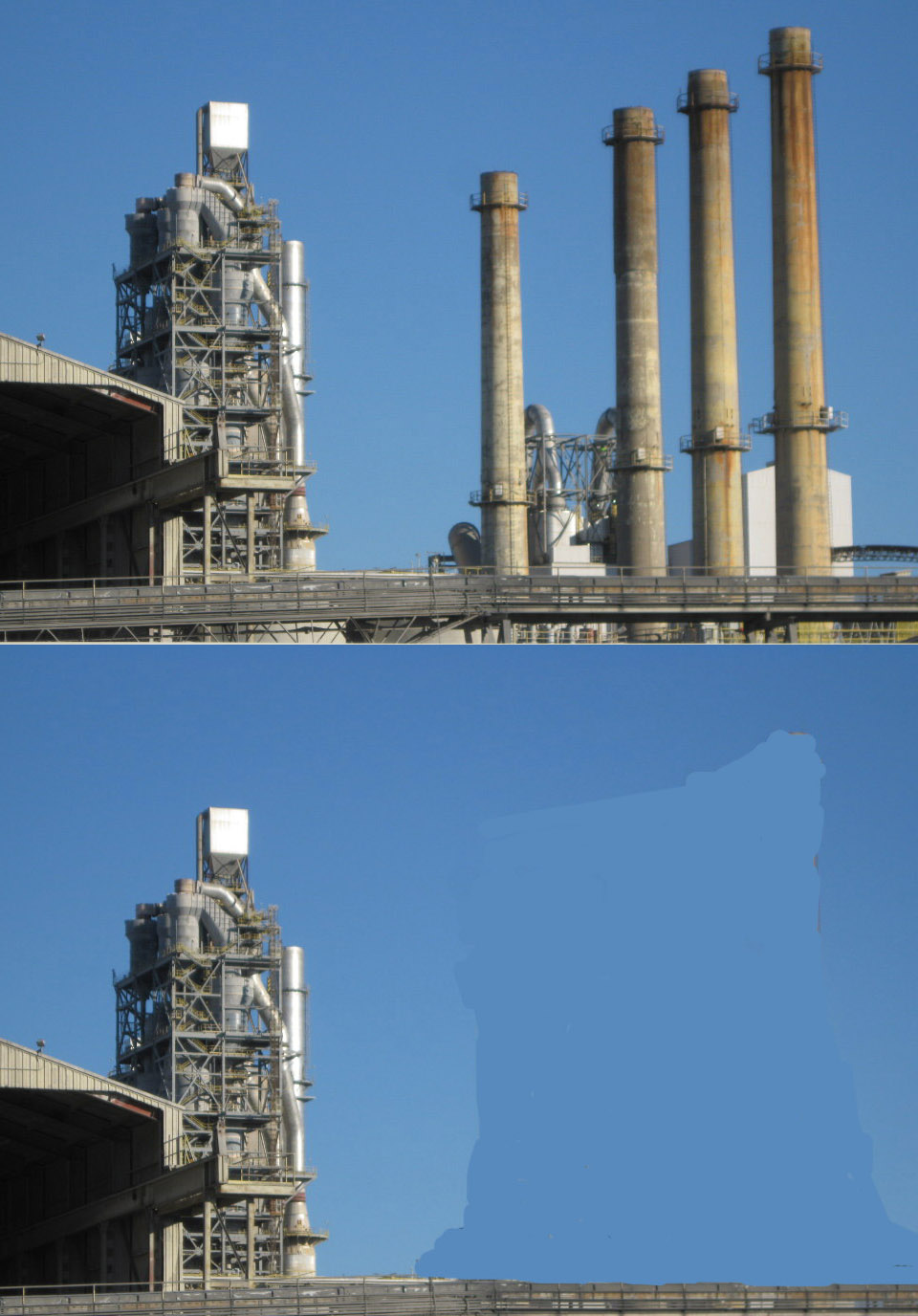 How's this for a track record over the last seven years?
How's this for a track record over the last seven years?
TXI's cement plant no longer has four hazardous waste-burning kilns.
The smokestacks are gone.
Likewise, the smokestacks from Frisco's outlaw Exide lead smelter are gone as well.
And there are still no drilling rigs in Dallas.
When citizens come together with a plan of action and the resources to follow-though, we make things change for the better. We make the air cleaner. We make people healthier.
Now we need you to step up and help fill our fundraising smokestack with "funds, not fumes"
 Please Reward Effective Local Organizing That Gets Cleaner Air in Your Lungs.
Please Reward Effective Local Organizing That Gets Cleaner Air in Your Lungs.
Here's our Mission Statement:
"Downwinders at Risk Education Fund is dedicated to taking effective action on behalf of those being harmed by air pollution. Our goal is to build a strong grassroots constituency and create new strategies for clean air in North Texas. We do this by informing, connecting and mobilizing citizens to become active participants in the decision-making that affects the air we breathe. In doing so, we improve both the quality of our air and the quality of our democracy."
We only have a few hours left to raise the the last $3000 of our $7500 goal.
Thank you for your consideration.
Mid-Giving Day Report: We’ve got 1/3 rd of what we need. Help us make it 3/3rds.

As of right after lunch, we'd reached our goal of hitting $2500. Thanks to everyone who made that possible. But that's only 1/3rd of what we need to raise today to make sure we have enough money to sponsor a first-evergrassroots activists conference. Help us get that other $5000 by Midnight tonight. Share the link to those who have reason to care about clean air – asthmatic kids, parents with COPD, those with high heart attack or stroke risks. New-or soon-to-be moms and dads. Every little bit helps, but those amounts of $25 or more get larger by way of the Communities Foundation formula. Thanks…… https://www.northtexasgivingday.org/#npo/downwinders-at-risk-education-fund
Today Only – Fill These Stacks With Funds, Not Fumes
 Good Morning. It's North Texas "Giving Day."
Good Morning. It's North Texas "Giving Day."
From 6 am to 12 Midlnight tonight, online donations of $25 or more to Downwinders at Risk get multiplied or matched by the Communities Foundation of Texas.
This year we're asking your help in supporting our first ever annual grassroots citizen activist conference, the Root and Branch Revue.
Not only will this conference offer DFW residents the chance to hang out, talk with, and learn from legendary environmetnal icon Lois Gibbs. You'll also meet and learn from her husband, harvard-trained toxicologist, Dr. Stephen Lester. This is the first time these two have teamed up to come to Texas and do citizen training.
Just as important are the peer-to-peer discussions and brainstorming sponsored by the conference. Not only will we host a two-hour panel discussion on the future of fighting fracking in Texas at our kick-off on Thursday, November 5th, but we'll folow that up with a second two-hour follow-up session on fracking strategy as part of our full day of workshops on Saturday, November 7th. In between, we'll be staging a "Get Tough with Texas" rally at EPA HQ in downtown Dallas that will spotlight why the feds need to crack down on Austin's "nullification" of evironmental laws and policy.
Downwinders fights for your lungs 365 days a year. Today, we need you to fight for us. Thanks very much for your consideration. Donate here.
A Major Announcement from Downwinders at Risk
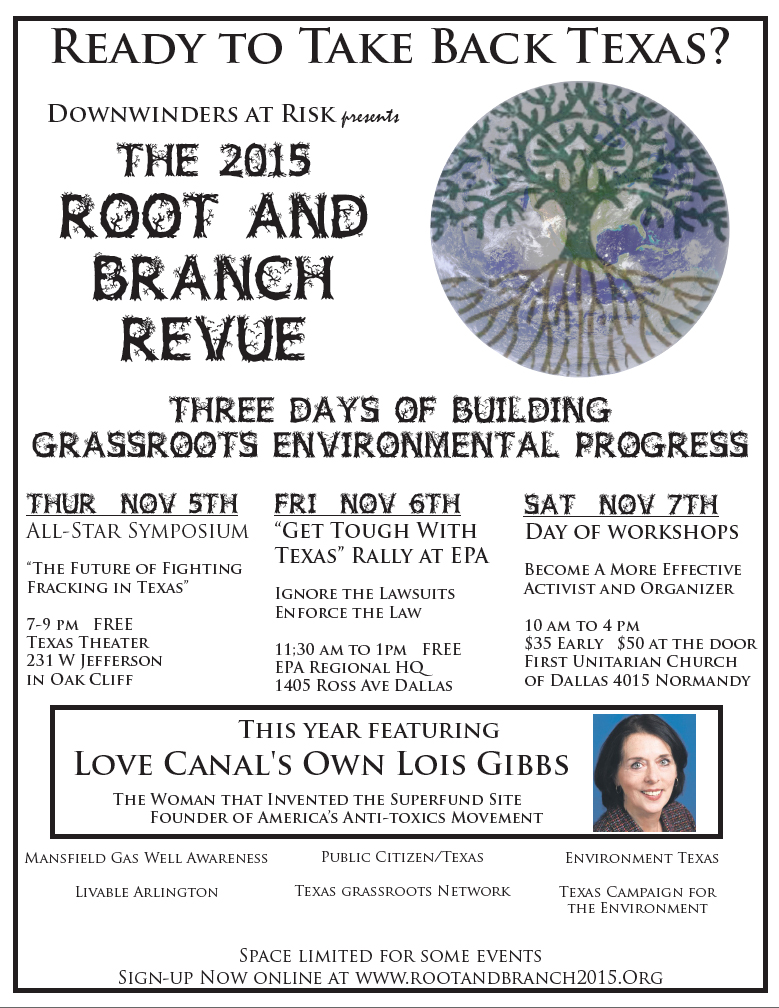
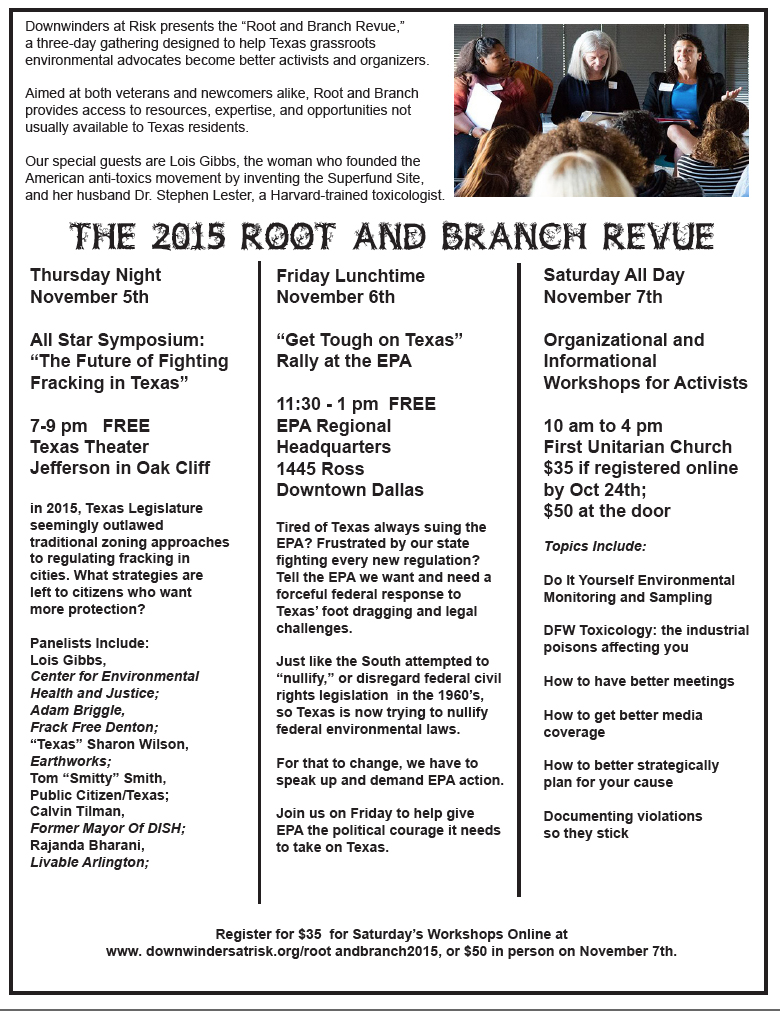
Group Announces Texas Grassroots Conference in November; Billed as
“The SXSW for Environmental Activists”
Love Canal’s Own Lois Gibbs Will Be Featured Guest At the First Annual “Root and Branch Revue”
(Dallas) — Saying their intent is to build a stronger grassroots environmental movement across Texas that can stop the state’s nullification of federal environmental laws and the rollback of rights to oppose large polluters, leaders of the local clean air group Downwinders at Risk announced an ambitious three-day conference in November aimed at honing the skills of Texas' citizen-activists.
Called “The Root and Branch Revue,” the event will feature Love Canal's Lois Gibbs, sometimes referred to as "the Rosa Parks of the Environmental Movement," and kick-off with a panel discussion on “The Future of Fighting Fracking in Texas” that will examine what tools citizens have in a post HB-40 world. Passed by the state legislature this last spring, HB 40 was the controversial bill prohibiting municipalities from using traditional zoning to regulate the location and operation of oil an gas facilities.
Scheduled for Thursday, November 5th through Saturday the 7th, the Revue is actually a rolling collection of events that includes the panel discussion, a lunchtime “Get Tough on Texas” rally at EPA regional headquarters in downtown Dallas, and a full day of workshops that will pass along tips on how to do your own air sampling and monitoring, get better media coverage for your cause, have more effective meetings .
Planners are also talking with the Dallas-based "hyper-local" Bar Politics comedy troupe for a environmentally-themed show as part of the festivities. This is not your typical environmental conference.
"We're billing it as the South by Southwest for activists," said Downwinders' board member and conference coordinator Tamera Bounds. "We want to offer a lot of different experiences – training from experts, brainstorming and socializing with your peers, and a chance to rally at EPA's regional headquarters with everyone else getting the shaft from Austin."
Bounds said Downwinders hopes to make the Revue an annual affair and wanted to kick off the tradition by inviting the original "hysterical housewife" who founded America's anti-toxics movement. “Downwinders and every other group like us can trace our origins back to Lois Gibbs' fight at Love Canal. She’s the mother of us all, and for our first year we wanted to honor that history."
Gibbs’s involvement in environmental causes began in 1978 when she discovered that her 7-year-old son’s elementary school in Niagara Falls, New York was built on a toxic waste dump containing over 20,000 tons of poisons, including Dioxin. Investigation revealed that her entire neighborhood, Love Canal, had been built on top of this dump. With no prior experience in community activism, Gibbs organized her neighbors and led her community in a battle against the local, state, and federal governments. After years of struggle, 833 families were eventually evacuated, and cleanup of Love Canal began. National press coverage made Lois Gibbs a household name and her efforts led to the creation of the U.S. Environmental Protection Agency’s “Superfund,” toxic waste clean-up fund.
In 1980, Gibbs formed the Citizens’ Clearinghouse for Hazardous Waste, later renamed the Center for Health, Environment and Justice (CHEJ), where she currently serves as Executive Director. CHEJ is a grassroots environmental crisis center that provides information, resources, technical assistance and training to community groups around the nation. It will be the first time Gibbs will be coming to train citizens in Texas. She'll be joined by her husband, Harvard-trained toxicologist Stephen Lester, who serves as Science Director for the Center.
All but a few events of the conference will be free. Saturday's day of workshops costs $35 if you register early, $50 if you don't. And that includes lunch.
You can find out more details, and sign-up for the day of workshops at the conference website:
Next Week is Giving Day: Help Us Bring Lois Gibbs to Town
 As many of you already know, Next Thursday, September 17th is North Texas "GIVING DAY."
As many of you already know, Next Thursday, September 17th is North Texas "GIVING DAY."
They'll be an All-Star panel on the future of fighting fracking in Texas after HB40.
They'll be a rally at EPA headquarters to demand the Agency enforce evnironmental laws.
They'll be an entire day of workshops on how to be a better activists. Want to know how to do your own air or water sampling? Get better media coverage? What industrial poisons affect you in DFW? You can learn from the experts.
It looks like they'll even be a comedy troupe review taking aim at DFW's air pollution.
But we need your help to pull this first-ever conference off and do it right. Our goal is to raise $7500 next Wednesday to help cover the expenses of our speakers, book our venues, and provide food and materials.
We're STILL the only group solely focused on DFW air quality.
We're STILL the only group with a full time staffer devoted to your lungs.
And we're STILL completely dependent on local contributions from our supporters to stay in business
 EALLY need you to take the time next Thursday to give generously to an effort that affects the very air you breathe. And keep on the lookout in your mailbox for news about our first-ever grassroots conference for people just like you.
EALLY need you to take the time next Thursday to give generously to an effort that affects the very air you breathe. And keep on the lookout in your mailbox for news about our first-ever grassroots conference for people just like you.
Going Backwards: DFW’s Annual Smog Average Went Up Twice in Two Days Last Week
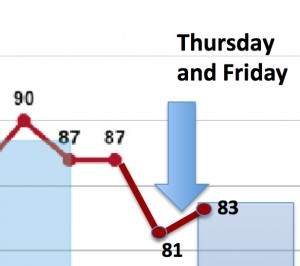 State officials and industry PR types thought they'd caught a break last summer when two things produced a much lower annual smog average, called a "Design Value."
State officials and industry PR types thought they'd caught a break last summer when two things produced a much lower annual smog average, called a "Design Value."
Since it's a three-year rolling average of smog numbers, past years roll off as new ones come on. Smog numbers from 2011 that had been so high they'd sent the average soaring, were finally rolling off and wouldn't be included in the average.
Second, unusually cooler temperatures and rain kept a new round of numbers lower. Combined, these factors resulted in a significant decrease in the smog average for 2014.
But in 2015, a more typical summer, or at least August, is bringing the average back up (Over 60% of the 100 highest recorded levels of smog this summer occurred in the last 30 days). Smog levels are higher across the board this year than last. There are more monitors recording more "exceedences" of the national smog standard. Leading them all is the Denton monitor, which saw ozone levels rise on Thursday and then skyrocket on Friday. The numbers were so high on both days they moved the needle of the annual smog average, the DFW Design Value, up from 81 to 82 parts per billion (ppb) on Thursday and up to 83 ppb on Friday. The standard is 75 ppb.
Even though Houston has recorded higher smog numbers than DFW this year, 2014's lower smog numbers was even more anomalous for that city than for North Texas. Last year's much lower numbers in the Bayou City are canceling out this year's much higher numbers. So that in 2015, DFW's Denton monitor's annual average of 83 ppb is the highest in the State of Texas.
And that means that according to the official accounting of the Clean Air Act, DFW has dirtier air than Houston. And not for the first time.
It also means we're rolling backwards in terms of air quality progress. With at least a whole month of "ozone season" to go, DFW's smog average is now only a little lower than it was in 2009. It would only take one or two more bad days to raise the average again.
This is the second time in four years that DFW's smog average has increased during the implementation of a state clean air plan for the area. Neither plan required new controls on large industrial polluters significantly contributing to the problem, like the gas industry, East Texas coal plants, and Midlothian cement kilns. There may be some connection there.
Given the state's stellar two decade-old track record of never meeting a clean air plan deadline, its latest plan was always likely to fail. But a federal court roll back of the deadline to get to the 75 ppb standard at all DFW monitors, from 2018 to 2017, plus these new 2015 smog numbers, make it DOA in the real world.
However, in the regulatory world governing these things officially, the plan is still being reviewed by the EPA and, believe it or not, could get approved if citizens don't make a big stink.
That's why you need to sign our Change.org petition to EPA to reject the state's plan and send an email to EPA officials requesting they write a new clean air plan instead of the state of Texas.
Many clean air advocates cautioned that 2014 should be seen as a outlier, and this summer is justifying that caution. If the experts are right, climate change will mean future summers will be more like 2011 than 2014. We've got to have a more realistic approach to the goal of safe and legal air. The State of Texas will not provide that. EPA can.
First Year Result of State’s New Clean Air Plan? DFW Smog Gets Worse
 Yesterday's smog wasn't the worst DFW has seen in 2015, but it was bad enough to make sure the first year of the State's proposed clean air plan for the area concludes with worse smog than when it started. Denton's running smog average inched up from 81 parts per billion in 2014 to 82 ppb at about 9 pm last night, with a month of hardcore ozone season left.
Yesterday's smog wasn't the worst DFW has seen in 2015, but it was bad enough to make sure the first year of the State's proposed clean air plan for the area concludes with worse smog than when it started. Denton's running smog average inched up from 81 parts per billion in 2014 to 82 ppb at about 9 pm last night, with a month of hardcore ozone season left.
This is the second time DFW's smog average has increased in the last four years. The last time it happened was in the middle of implementing a state clean air plan that imposed no new controls on any large polluters. This time it happened just as another such plan was being submitted to EPA for approval.
There has been a lot of crowing from Austin and industry about how much DFW ozone levels decreased last year. But most of that was weather-related. It was unusually wet and cool. As a result, in 2014, there were only two (out of 20 ) DFW monitors that had official ozone violations of 75 ppb or above. This year, and especially this August, has been a bit more normal. There are already nine monitors that have registered violations of 75 or above.
Moreover, DFW's running three-year smog average, or what the EPA calls the Design Value, is the worst in the state now, surpassing Houston despite both metro areas having bad ozone seasons this year. As of today, its 82 ppb average means Denton holds the dubious honor of hosting the ozone monitor with the state's highest Design Value. The second worst is the Ft. Worth Nortwestern (Meachum Field) monitor, tied with a monitor in Houston. These facts lend credence to clean air advocates' claims that last year's low smog levels were an anomoly and not the beginning of a new trend.
Thanks to a federal court case back in December, the official deadline for meeting or exceeding the current 75 parts per billion ozone standard at all 20 DFW monitors is now 2017, instead of 2018. That means this year's bad numbers will be used with those in 2016 and 2017 in averaging a new Design Value and declaring the success or failure of the state's clean air plan by September of 2017.
Because of the last three or four weeks of bad air, the gap between where we are (82ppb) and that 75 ppb goal is wider. As of now, the next two summers have to be as cool and wet as 2014 to even have a chance of decreasing ozone by the 7 ppb or more needed to get down to the legal limit.
And – of course that legal limit is going to be revised in October when EPA decides what the new national ozone standard will be, probably somewhere between 65 and 70 ppb.
So….let's review. Air quality in DFW is worse this year than last. We're starting from further behind than we were at the beginning of summer. The state has turned in a new clean air plan to EPA that once again doesn't require any new controls on any major polluters – kilns, coal plants or natural gas, even though we need deep decreases in smog pollution to get safe and legal air by the new federal deadline.
That's why we need the EPA to take the job of drafting a new clean air plan out of the hands of a state agency unwilling to enforce the law and do it themselves via a Federal Implementation Plan, or FIP. Until the grown-ups are in charge, DFW will never see a clean air deadline met.
Sept 23rd: Dallas is Site to One of Three National Public Hearings on EPA’s New Methane Rules – Speak Up to Include Them in Current Air Plan
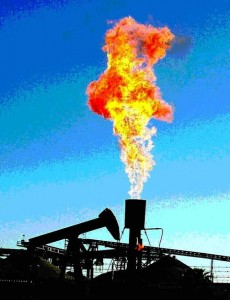 Hot off the presses, the EPA published notice in this morning's Federal Register that Dallas will be the site of one of only three national public hearings the Agency is hosting concerning its proposed rules designed to reduce methane emissions at new oil and gas indusry facilities.
Hot off the presses, the EPA published notice in this morning's Federal Register that Dallas will be the site of one of only three national public hearings the Agency is hosting concerning its proposed rules designed to reduce methane emissions at new oil and gas indusry facilities.
On September 23rd, from 9 am until 8 pm in the Dallas City Council Chambers, the EPA will be accepting testimony from the public, in five-minute increments. You can register for your five minute slot online at www.epa.gov/airquality/oilandgas/ between now and September 18th.
Announced to great fanfare only last week, the rules promise to cut future pollution levels as new equipment comes on line, but does nothing about existing faciltiies – with one important exception.
For metropolitan areas like DFW that host large concentrations of gas pollution sources AND are in violation of the Clean Air Act for their smog pollution, EPA has said that states must address new “Control Technique Guidelines” written by the Agency to reduce missions of Volatile Organic Compounds as part of thier smog-figthing plans for those areas. That's good because its smog-forming VOC pollution like Benzene and Toluene that also makes up some of the most toxic air pollution these facilities can emit. The catch is that the rules give the states a two year grace period.
That means that even though the State of Texas and EPA are wrestling over a clean air plan for DFW right now, and even though one of the major smog-polluting industries in DFW are the 17,000 or so wells, almost 700 large compressors and thousands of other oil and gas facilities in North Texas, those new Control Guidelines will not have to be included in that current plan. But they should be.
If you're going to testify, please be sure to make the request that the EPA and Texas go ahead and include these "VOC CTGs" for non-attainment areas in the current DFW air plan. These are anti-smog measures that are no-brainers in a region which has never been in compliance with the Clean Air Act. And they also mean a total reduction in hazardous air pollution.
For more information about the public hearings, contact Ms. Aimee St. Clair, Office of Air Quality Planning and Standards (E143–03), U.S. Environmental Protection Agency, byphone at (919) 541–1063, or by email at StClair.Aimee@epa.gov.
The Impact of the EPA’s New Methane Rules on the Barnett Shale? TBD
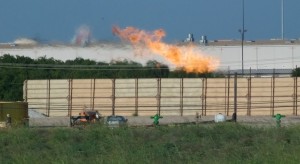 Despite all the gnashing of teeth by industry and hallelujah choruses from the Big Green groups, the new methane rules proposed by the Obama Administration this last week have no immediate impact on facts on the ground in the Barnett Shale.
Despite all the gnashing of teeth by industry and hallelujah choruses from the Big Green groups, the new methane rules proposed by the Obama Administration this last week have no immediate impact on facts on the ground in the Barnett Shale.
That’s because, like the recent coal CO2 rules, they regulate future facilities, not the 17,000 or so wells, plus infrastructure, already operating in the Barnett.
They do bring a welcome spotlight to “downstream” facilities like gathering lines and compressors, which is where most of the methane in the gas fuel cycle escapes. They also concede the connection between methane releases and smog (“…reduction of VOC emissions will be very beneficial in areas where ozone levels approach or exceed the National Ambient Air Quality Standards for ozone”), as well as methane and more toxic Volatile Organic Compounds such as Benzene and Toluene (“The measures proposed in this action achieve methane and VOC reductions through direct regulation. The hazardous air pollutant (HAP) reductions from these proposed standards will be meaningful in local communities.”)
EPA’s new rules set a floor for emissions that the industry, over time, will eventually get closer to meeting as a while with the turnover of equipment. But that could take decades. Meanwhile, the agency is only offering “guidelines” to states with smog problems – like Texas – for new pollution controls to reduce methane at existing facilities.
Under this part of the regulation, areas like DFW that host large concentrations of gas pollution sources and are officially categorized as “non-attainment” for smog, or ozone, standards will supposedly be the beneficiaries of new EPA-written “Control Technique Guidelines.”
According to EPA, these CTGs “provide an analysis of the available, cost-effective technologies for controlling VOC emissions from covered oil and gas sources. States would have to address these sources as part of state plans for meeting EPA’s ozone health standards.”
If you live in Texas, you’ve already chortled at that last sentence. Really? The Texas Commission on Environmental Quality (TCEQ) would have to use these new technologies on gas sources in their new clean air plans for DFW? Something they’ve refused to do for the last two clean air plan cycles dating back to 2010?
Well, they have to address them at least. And a lawsuit aimed at gutting the new rules is a form of addressing isn’t it?
These are guidelines only, up to the state to enforce – as the EPA admits. “States have some discretion in applying these guidelines to individual sources.” The leverage EPA has is that it still needs to approve these state-generated clean air plans and it can make an official determination that a state didn’t follow the guidelines and send it back to be amended.
This might not be all that important except that the State of Texas is going to have to write a new air plan for DFW in the next year or face the prospect of a federal plan being written in its stead. The one Austin submitted in July is already falling apart on several fronts, and TCEQ has to submit a whole new version or face an EPA-imposed one.
Will the state at least have to acknowledge these guidelines in this current air plan controversy? No. The states have two years to fold the proposed CTGs into their SIPs. So they don’t even have to come into play until this current state plan fails, and Austin or the EPA begin to write a replacement. And why might this plan fail? In part, because it doesn’t apply modern controls to major sources like oil and gas facilities.
You might remember in July, a total of 11 studies were collectively released that concluded the Barnett Shale was leaking 50 percent more methane than previously thought. The day before the EPA made its announcement this week, a national version of those studies estimated US methane pollution from oil and gas was being underestimated by 30%. That’s important because many models of air pollution used by the EPA and the states use those standard emissions estimates that now look obsolete. If you increase the amount of methane, and associated pollutants, by 30-50% in those models, the results might look very different.
So even though the state isn’t officially required to include this new approach to decreasing VOC pollution until 2017 or later, it’d be nice to see it adopted now and have an immediate impact on a region that has a longstanding chronic smog problem. But as long as Texas is in charge of writing DFW’s air plans, that’s just not gong to happen.
Expect Obama’s New CO2 Plan to Close Those Nasty East Texas Coal Plants? Don’t.
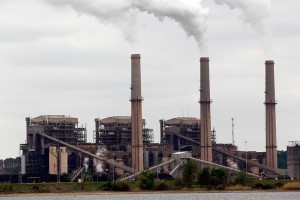 By this point, most of you will have been inundated with opinions and factoids about what President Obama's new "Clean Power Plan" will and won't do about climate change. Bottom Line: while it sets a precedent and an emissions floor for the largest sources of CO2, it does so in a way which turns out to be not so challenging for most states – including Kentucky deep in Coal County.
By this point, most of you will have been inundated with opinions and factoids about what President Obama's new "Clean Power Plan" will and won't do about climate change. Bottom Line: while it sets a precedent and an emissions floor for the largest sources of CO2, it does so in a way which turns out to be not so challenging for most states – including Kentucky deep in Coal County.
That's also true for Texas, where besides being Ground Zero for the fracking boom, we also have plenty of wind power and some solar. According to the EPA, the state must cut an annual average of 51 million tons of carbon to reach its target, a reduction of about 21 percent from 2012 emissions. We're well on our way to achieving most of that reduction with current or planned wind, gas, hydro, and solar. (In what might be a first concession that natural gas shouldn't be a long-term "bridge fuel," some analysts think tweaks performed by EPA prior to the Plan's release give more incentives to adopt real renewables earlier rather than leaning on gas in the interim.)
This is mostly good news. We want the wind and solar economies to grow. The trade-off is that, under Obama's Clean Power Plan, the rise of these technologies and their emissions reductions lets the obsolete East Texas coal plants off the hook because you don't need them to close to meet your CO2-cutting goals.
Five of those obsolete coal-fired power plants surround DFW's eastern side in a half circle (Big Brown, Martin Lake, Monticello, Limestone, and Welsh). They are, without a doubt, the worst examples of fossil fuel-generated pollution in Texas. They're huge emitters of Mercury, Particulate Matter (PM), Sulfur Dioxide (SOx), and Nitrogen Oxides (NOx).
These five East Texas coal plants are projected by the state to still be releasing 150 tons a day of smog-forming NOx pollution in 2018. Because of wind direction and volume, that pollution has a very large impact on DFW air quality – probably more than any other single phenomenon. We need those coal plants to either modernize or close ASAP to help solve our chronic smog problem. But from the initial survey of the policy, the Clean Power Plan is not going to force that outcome.
While the Plan probably signals the end of any new coal plants any time soon, or at least none without CO2 solutions like sequestration or capture, the fate of existing coal plants, especially in a state like Texas, is more ambiguous. More likely, they'll continue to linger on, beneficiaries of friendly state-created policies designed to nullify the requirements of the Clean Air Act, like loosening their PM limits by magnitudes.
Now, you might think that a federal goal that's been mostly accomplished without doing anything new would be a no brainer in Austin, but there are increasingly fewer and fewer brains in Austin. Because the state's environmental agencies are now completely ideologically driven, common sense just isn't a factor anymore. Instead of asking "how can we best solve this problem?" the response is now to deny there's a problem at all and go about ginning up anti-federal hyperbole to better position yourself in the Republican Primary.
Consequently, the Texas Commission on Environmental Quality is seriously considering not turning in a required state plan of how to get the reductions needed by the deadline of 2030. If the state doesn't submit one of its own, then the EPA would write one for them. This has the business community in Texas a little nervous, since they have a lot more influence here than in DC. But citizens, which kind of anti-climate change plan would you rather have Texas abide by – one written by a state agency that denies climate change is happening and is doing everything it can to obstruct policies to prevent it, or one written by a federal agency that's actually acknowledging the obvious and doing something about it?
Regardless of whose plan does what by when, the East Texas coal plants look to be able to ride this federal policy out thanks to an almost two-decade homegrown drive to open up the state to renewables. If we want these coal plants to stop causing problems for us, we're probably going to have to find other leverage points.
One of these leverage points is demanding the state of Texas follow the law and require the coal plants install modern Selective Catalytic Reduction controls as part of the new DFW clean air plan it submitted to EPA this summer for approval. SCR could reduce smog pollution from these plants by 90%. So far, Texas has refused to even acknowledge the need to do so. EPA has requested the state change its mind – without success.
If it wants to, EPA can reject the state's plan for not including these new controls on the coal plants. But we have to encourage them to do so – by petition, and by e-mail.
Consider the five East Texas coal plants the energy sector equivalent of the obsolete "wet" kilns in Midlothian that burned hazardous waste for 20 years. They're technological dinosaurs, on their last legs, but still churning out tons and tons of harmful air pollution as they plod their way to the bone yard. The Clean Power Plan insures they'll be the last of their kind, but it's not a silver bullet.

